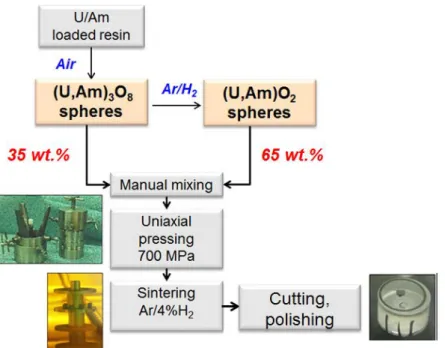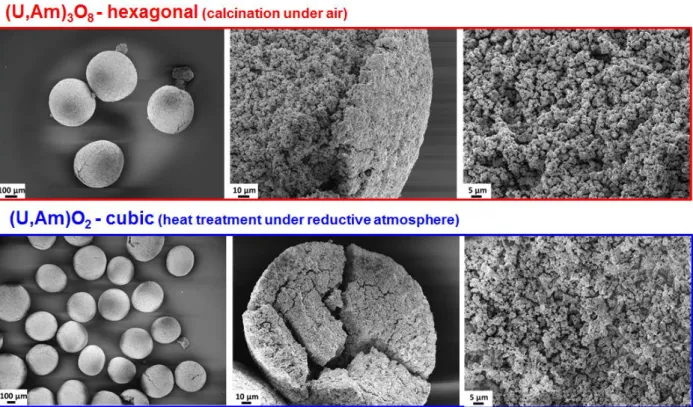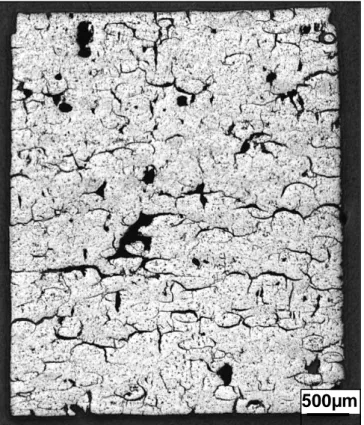HAL Id: cea-02421920
https://hal-cea.archives-ouvertes.fr/cea-02421920
Submitted on 20 Feb 2020HAL is a multi-disciplinary open access archive for the deposit and dissemination of sci-entific research documents, whether they are pub-lished or not. The documents may come from teaching and research institutions in France or abroad, or from public or private research centers.
L’archive ouverte pluridisciplinaire HAL, est destinée au dépôt et à la diffusion de documents scientifiques de niveau recherche, publiés ou non, émanant des établissements d’enseignement et de recherche français ou étrangers, des laboratoires publics ou privés.
Fabrication of (U,Am)O_2 pellet with controlled
porosity from oxide microspheres
Laure Ramond, Philippe Coste, Sébastien Picart, A. Gauthé
To cite this version:
Laure Ramond, Philippe Coste, Sébastien Picart, A. Gauthé. Fabrication of (U,Am)O_2 pellet with controlled porosity from oxide microspheres. Journal of Nuclear Materials, Elsevier, 2017, 492, pp.97-101. �10.1016/j.jnucmat.2017.05.005�. �cea-02421920�
Fabrication of (U,Am)O
2pellet with controlled porosity from oxide microspheres
Laure Ramond*1, Philippe Coste 1, Sébastien Picart2 and Aurélie Gauthé31DEN/DMRC/SFMA/LFC 2DEN/DMRC/CETAMA 3DEN/DMRC/SFMA/LPCA
CEA MARCOULE - 30207 Bagnols-sur-Cèze, FRANCE
Abstract
U1-xAmxO2±δ mixed-oxides are considered as promising compounds for americium heterogeneous
transmutation in Sodium Fast Neutron Reactor [1–3]. Porous microstructure is envisaged in order to facilitate helium and fission gas release and to reduce pellet swelling during irradiation and under self-irradiation. In this study, the porosity is created by reducing (U,Am)3O8 microspheres into
(U,Am)O2 during the sintering. This reduction is accompanied by a decrease of the lattice volume that
leads to the creation of open porosity. Finally, an (U0.90Am0.10)O2 porous ceramic pellet (D~89% of the
theoretical density TD) with controlled porosity (≥8% open porosity) was obtained from mixed-oxide microspheres obtained by the Weak Acid Resin (WAR) process [4].
1. Introduction
Even though neptunium, americium and curium, known as the minor actinides (MA) represent less than 0.1 wt.% of the spent nuclear fuel, they are the main responsible for long-term radioactivity and heat load of the ultimate waste after plutonium recycling [5,6]. A possible option to reduce the long-term radiotoxicity of spent fuel nuclear wastes is to deploy MA transmutation into lighter short-lived elements, for instance in Fast Neutron Reactors (FNRs) developed in the framework of GEN-IV International Forum [1,7]. The program specially focuses on the transmutation of americium since this element is the most abundant and the most active among MA [2,8]. In France, among the different MA transmutation modes [2,9–11], heterogeneous transmutation is one of the most considered options for the future nuclear fuel cycle [1]. It consists in irradiating uranium–americium mixed-oxide compounds (U1-xAmxO2±δ) located at the core periphery. Such irradiation targets are
called AmBB (Americium Bearing Blankets) [3]. The content of americium [Am/(Am+U)] in such materials can reach 15 at.%. In this context, several processes are being developed to fabricate such mixed-oxide pellets which are to meet the specifications required to perform analytical irradiations such as Am content, O/M ratio (oxygen to metal with M = U + Am), chemical and microstructural homogeneity, pellet dimensions and density, open porosity ratio, etc [2,8,12,13].
The development of a dustless innovative route, adapted from the Weak Acid Resin process (WAR) is currently studied. It consists in impregnating resin microspheres with the desired element(s) in their cationic form and then in submitting the metal loaded resin to a calcination step to obtain the single or mixed-oxide microsphere precursors. Those microspheres are then shaped into pellets which are sintered to produce single or mixed-oxide ceramic. The over-all process is the so called Calcined Resin Microsphere Pelletizing (CRMP) process [12].
The fabrication of dense pellets by CRMP process was demonstrated for compounds such as UO2 [14]
and (U,Am)O2 [15]. Tailored-porous samples from oxide spheres were fabricated only for UO2 [16]. As
the main objective of MARIOS and DIAMINO irradiations was to assess the influence of the fuel microstructure (dense and porous), it could be important to also demonstrate the feasibility of (U,Am)O2 pellets fabrication with controlled density from CRMP process for an eventual future
irradiation. Indeed, the porous microstructure is considered to facilitate the release of helium produced during irradiation but also to limit pellet swelling under self-irradiation.
In this study, we focus on demonstrating the feasibility of the fabrication of porous ceramic pellets with controlled porosity (8-10% open porosity) from mixed-oxide microspheres obtained by the Weak Acid Resin (WAR) process [4]. An (U0.90Am0.10)O2 pellet with controlled porosity (89%TD) and
with an open porosity of 9% was fabricated.
2. Experimental
2.1.1. Resin preparation
The ion exchange resin used for the fixation was an IMAC HP333 carboxylic resin supplied by Dow Chemicals (Chauny, France). The resin was manually sieved under deionised water and the 630-800 µm diameter size range was collected for the fixation. The resin was introduced in a column to be washed by successive percolations of 1 M nitric acid (HNO3 - Fisher Chemical, Certified ACS
Plus), demineralized water, 1 M ammonia solution (Merck, Pro Analysis) and demineralized water again. Eventually, the washed resin was prepared in its protonated form by a final percolation of 1 M HNO3, followed by a demineralized water rinse cycle.
2.1.2. Preparation of the loading solution (U/Am)
The mixed loading solution was prepared in several steps. An americium nitrate solution (Am(NO3)3)
was first obtained by the dissolution of 3 g of AmO2 powder in a 0.85 mol.L-1 nitric acid solution. The
solution corresponds to a volume of 125mL and to a 0.84 mol.L-1 Am nitrate solution. The second
step is the adding of 17 g of trioxide solid (UO3) in the previous solution to increase both pH and
uranium concentration by reacting with acid excess and by forming hydrolysed uranyl species. The final solution corresponded to an Acid Deficient Nitrate Uranyle solution (ADUN) [17] with the following uranium formula UO2(NO3)1.25(OH)0.75 and with uranium and americium concentrations of
0.111 and 0.012 mol.L-1, respectively, an Am over metal [Am/(Am+U)]= 10.1 ± 0.2 at.%) and a volume
of 860 mL.
2.1.3. Impregnation
The resin microspheres (about 7 g) were first introduced and rehydrated into a plexiglass column column (1.5 cm internal diameter and 16 cm height). Fixation of both UO22+ and Am3+ cations was
performed by percolating the ADUN solution by recirculation through the column during 5 h. pH of the loaded solution was recorded during impregnation. The cations exchange reaction was considered as achieved when the pH did not change significantly. The loaded resin was rinsed with deionised water before being drained under low vacuum. The microspheres were then transferred in quartz crucible, shown in Figure 1, to be calcined in air at 700°C for 4 h. A part of these oxide microspheres (65 wt.%) was secondly reduced in Ar/4vol.%H2 at 700°C for 5 h.
A content of 11.1 ±0.2 at.% Am measured by TIMS analysis by dissolving 20 mg of reduced oxide microspheres (U,Am)O2 in nitric acid (5 M), which can demonstrate the quasi-congruence of the Am
Figure 1 : Pictures of U-Am oxide microspheres synthesis in hot cell in Atalante facility. From left to right: loaded resin in plexiglass column, loaded resin in the quartz crucible before calcination in
airflow and oxidized (U,Am)3O8 microspheres.
2.1.4. Calcination - Thermal treatment
Two thermal treatments were then applied to the loaded resin in an instrumented tubular furnace. The resin was first calcined at 700°C for 4 h under air flow (15 NL/h) with a low heating rate of 2K.min-1 preventing any microsphere degradation and guarantying a proper homogeneity of the
calcination temperature (mass loss of 53.5%). A part of the latter was then submitted to a second heat treatment under reductive atmosphere Ar/4vol.%H2 (12 NL/h) at 700°C for 5 h with a heating
rate of 10 K.min-1.
Crystalline structure analyses on the resulting oxide were performed by X-ray diffraction (XRD) using a Bruker D8 Advance diffractometer (Madison, WI) with a Cu X-ray source (Kα1/α2, λ = 1.54059/1.54439 Å) and equipped with a special sample holder for radioactive material measurements. The oxide microspheres were first milled manually and then mixed in grease with Au powder (Sigma Aldrich, >99.9%). Gold is used as standard to control any potential instrumental deviation.
A nuclearized ZEISS Supra 55 VP Field Emission Gun (FEG) scanning electron microscopy (SEM (Oberkochen, Germany) was used for the morphology and the microstructure observations of the oxide microspheres.
2.2. Fabrication of sintered (U,Am)O2 pellet with controlled porosity
In this study the porosity was not created by under densification but by the introduction of (U,Am)3O8 as a inorganic pore-former. A reductive sintering of a mix of (U,Am)3O8 and (U,Am)O2
microspheres led to the creation of open porosity thanks to the transformation of (U,Am)3O8 into
In order to obtain porous samples with a density in the 86-90% TD range, the specific ratio of 65 wt.% of reduced microspheres (U,Am)O2 were mixed with 35 wt% oxidized microspheres (U,Am)3O8. After
the pelletization step at 700 MPa in a three-part matrix (5.0 mm diameter), the green pellet (about 600 mg) was sintered under reductive atmosphere at 1700°C-4h in a high temperature furnace. The flowchart of this porous pellet fabrication process is shown in Figure 2.
Figure 2 : Porous pellets fabrication flowchart using oxide microsphere precursors.
Accurate diameter measurement was performed for sintered pellet using a laser micrometer coupled to a step motor to allow measurements in the whole height every 20 µm.
Optical microscopy was performed on polished sample using an Olympus BX30M.
XRD analyses were performed on powdered sintered pellet using the same method as described in paragraph 2.1.4.
3. Results and discussion
The XRD patterns obtained from the powdered oxide microsphere after calcination under air and followed by a reduction step under Ar/4vol.%H2 are presented in Figure 3 in red (bottom) and blue
(top), respectively.
After the calcination under air, the XRD pattern is characteristic of a single hexagonal phase (P-62m) with the following refined parameters a=6.838 (1) Å and c=4.165 (1) Å.
After the reduction under Ar/4vol.%H2, only peaks derived of a single fluorite-type phase (Fm-3m)
are visible which proves the quantitative reduction of (U,Am)3O8 to (U,Am)O2 during the second
thermal treatment. The refined lattice parameter was found equal to 5.467 (1) Å. This parameter is higher than the one previously obtained by E. Remy et al. [15] (5.4511 Å) with the same CRMP process, which indicates a higher reduction for our sample.
Figure 3 : XRD patterns for U-Am oxide microspheres after the first calcination (air, bottom), and after second heat treatment (Ar/4vol.%H2, top) (*gold standard).
SEM observation (Figure 4) revealed that the spheres have a porous microstructure after calcination under air as well as after the second heat treatment under Ar/4vol.%H2.
Figure 4 : FEG-SEM micrographs in secondary electron mode showing oxidized and reduced microspheres.
3.2. Characterization of sintered (U,Am)O2 pellet
After sintering, the final pellet (m = 560 mg, h = 4.4 mm, diameter = 4.1 mm) is rectilinear and neither deformations nor particular defects were observed.
A percolating porosity network was created during the reductive sintering by volume shrinkage of (U,Am)3O8 phase in (U,Am)O2. This network is homogeneously spread into the whole sample.
3.2.1. Density and microstructure
The final density was obtained via the Archimedes method in bromobenzene. It was found a density of 89% TD with 9% of open porosity and 2% of closed porosity. These characteristics strongly fit with the required porous pellet specifications for previous irradiation programs (86-89%TD, with open porosity ≥8%) such as MARIOS [18,19].
Figure 5 presents a longitudinal observation of the sintered (U,Am)O2 pellet by optical microscopy.
The porosity is homogeneously distributed through the pellet and the open porosity is interconnected on a long path. Memory form of ex-(U,Am)3O8 microspheres is rather hemispherical
and could be compared with the memory form of ex-U3O8-AmO2 agglomerates observed in MARIOS
samples which had no specific form.
Figure 5 : Optical microscopic observation of the internal microstructure of sintered (U,Am)O2 porous
pellet.
3.2.2. XRD analysis
XRD pattern obtained on the sintered pellet is characteristic of the fluorite-type phase, with a refined parameter of 5.470(1) Å. The latter is very close to usual lattice parameter found for U0.90Am0.10O2±δ
sintered pellets fabricated by metallurgical process [18,20]. The sintering step provided the total reduction of (U,Am)3O8 to (U,Am)O2, with a volume lattice decrease for an hexagonal to a fluorite
phase creating the visible open porosity network (Figure 5).
4. Conclusion and perspectives
This work focused on the fabrication of mixed-oxide pellets with controlled porosity by implementing the CRMP process. The synthesis of mixed-oxide microspheres by impregnation and calcination of loaded resin beads really limits the production of fine particles. Moreover, the CRMP process is a simplified one, with only two steps after the oxide microsphere synthesis: pelletizing and sintering.
The feasibility of porous AmBB fabrication was demonstrated for a potential heterogeneous transmutation of americium in FNRs by the fabrication of an 89% DT porous pellet with 9% of open porosity. The developed process allows a homogeneous distribution of the open porosity through the entire pellet created by the complete reduction of hexagonal (U,Am)3O8 into fluorite-type phase
(U,Am)O2.
This porosity network could be tuned by modifying the initial resin bead diameter or by doing a specific mix between several microsphere diameters.
Acknowledgements
The authors are thankful to P. Grangaud, J.M. Pomarède, Y. Sinot for uranium-americium mixed oxide microsphere synthesis, J.R. Sevilla for SEM observation, E. Pascal for optical microscopic observation, R. Vauchy and A. Joly for XRD on sintered (U,Am)O2.
References
[1] D. Warin, Status of the French Research Program on Partitioning and Transmutation, J. Nucl. Sci. Technol. 44 (2007) 410–414. doi:10.1080/18811248.2007.9711302.
[2] D. Prieur, A. Jankowiah, T. Delahaye, N. Herlet, P. Dehaudt, P. Blanchart, Fabrication and characterisation of U0.85Am0.15O2-x discs for MARIOS irradiation program, J. Nucl. Mater. 414
(2011) 503–507. doi:10.1016/j.jnucmat.2011.05.036.
[3] E. D’Agata, P.R. Hania, S. Bejaoui, C. Sciolla, T. Wyatt, M.H.C. Hannink, N. Herlet, A. Jankowiak, F.C. Klaassen, J.-M. Lapetite, D.A. Boomstra, M. Phelip, F. Delage, The results of the irradiation experiment MARIOS on americium transmutation, Ann. Nucl. Energy. 62 (2013) 40–49. doi:10.1016/j.anucene.2013.05.043.
[4] S. Picart, Rémy Elodie, Delahaye Thibaud, Method for preparing a porous nuclear fuel, WO2013026851 A1, 2012.
[5] Homogeneous versus Heterogeneous Recycling of Transuranics in Fast Nuclear Reactors, OECD/NEA PUBLISHING, Paris, France, 2012. https://www.oecd-nea.org/science/docs/2012/7077-hvh-recycling-transuranics-fnr.pdf.
[6] J.-M. Gras, R.D. Quang, H. Masson, T. Lieven, C. Ferry, C. Poinssot, M. Debes, J.-M. Delbecq, Perspectives on the closed fuel cycle – Implications for high-level waste matrices, J. Nucl. Mater. 362 (2007) 383–394. doi:10.1016/j.jnucmat.2007.01.210.
[7] The Generation IV Internationl Forum, (n.d.). https://www.gen-4.org/gif/ (accessed December 1, 2014).
[8] T. Delahaye, F. Lebreton, D. Horlait, N. Herlet, P. Dehaudt, Application of the UMACS process to highly dense U1-xAmxO2±δ MABB fuel fabrication for the DIAMINO irradiation, J. Nucl. Mater. 432
(2013) 305–312. doi:10.1016/j.jnucmat.2012.07.018.
[9] M. Salvatores, Transmutation : Issues, innovative options and perspectives, Prog. Nucl. Energy. 40 (2002) 375–402. doi:10.1016/S0149-1970(02)00031-8.
[10] R.J.M. Konings, K. Bakker, J.G. Boshoven, H. Hein, M.E. Huntelaar, R.R. van der Laan, Transmutation of actinides in inert-matrix fuels: fabrication studies and modelling of fuel behaviour, J. Nucl. Mater. 274 (1999) 84–90. doi:10.1016/S0022-3115(99)00043-4.
[11] F. Lebreton, D. Prieur, A. Jankowiak, M. Tribet, C. Leorier, T. Delahaye, L. Donnet, P. Dehaudt, Fabrication and characterization of americium, neptunium and curium bearing MOX fuels obtained by powder metallurgy process, J. Nucl. Mater. 420 (2012) 213–217. doi:10.1016/j.jnucmat.2011.10.016.
[12] E. Remy, S. Picart, S. Grandjean, T. Delahaye, N. Herlet, P. Allegri, O. Dugne, R. Podor, N. Clavier, P. Blanchart, A. Ayral, Calcined resin microsphere pelletization (CRMP): A novel process for sintered metallic oxide pellets, J. Eur. Ceram. Soc. 32 (2012) 3199–3209. doi:10.1016/j.jeurceramsoc.2012.04.011.
[13] M. Caisso, F. Lebreton, D. Horlait, S. Picart, P.M. Martin, R. Bès, C. Renard, P. Roussel, D.R. Neuville, K. Dardenne, J. Rothe, T. Delahaye, A. Ayral, Nanostructured gadolinium-doped ceria microsphere synthesis from ion exchange resin: Multi-scale in-situ studies of solid solution formation, J. Solid State Chem. 218 (2014) 155–163. doi:10.1016/j.jssc.2014.06.028.
[14] E. Remy, Étude de la synthèse de sphères d’oxyde d’actinides et/ou de lanthanides et de leur aptitude à la céramisation, Université de Montpellier 2, 2013.
[15] E. Remy, S. Picart, T. Delahaye, I. Jobelin, F. Lebreton, D. Horlait, I. Bisel, P. Blanchart, A. Ayral, Fabrication of uranium–americium mixed oxide pellet from microsphere precursors: application of CRMP process, J. Nucl. Mater. 453 (2014) 214–219. doi:10.1016/j.jnucmat.2014.06.048. [16] E. Remy, S. Picart, T. Delahaye, I. Jobelin, O. Dugne, I. Bisel, P. Blanchart, A. Ayral, Fabrication of
uranium dioxide ceramic pellets with controlled porosity from oxide microspheres, J. Nucl. Mater. 448 (2014) 80–86. doi:10.1016/j.jnucmat.2014.01.017.
[17] P.A. Haas, 3.800.023, 1974.
[18] D. Prieur, A. Jankowiak, D. Roudil, S. Dubois, C. Leorier, N. Herlet, P. Dehaudt, J.-P. Laval, P. Blanchart, Self-irradiation effects in dense and tailored porosity U1-yAmyO2-x (y = 0.10; 0.15)
compounds, J. Nucl. Mater. 411 (2011) 15–19. doi:10.1016/j.jnucmat.2010.12.314.
[19] F. Lebreton, D. Prieur, D. Horlait, T. Delahaye, A. Jankowiak, C. Léorier, F. Jorion, E. Gavilan, F. Desmoulière, Recent progress on minor-actinide-bearing oxide fuel fabrication at CEA Marcoule, J. Nucl. Mater. 438 (2013) 99–107. doi:10.1016/j.jnucmat.2013.02.079.
[20] D. Prieur, P.M. Martin, A. Jankowiak, E. Gavilan, A.C. Scheinost, N. Herlet, P. Dehaudt, P. Blanchart, Local structure and charge distribution in mixed uranium–americium oxides: effects of oxygen potential and Am content, Inorg. Chem. 50 (2011) 12437–12445. doi:10.1021/ic200910f.




